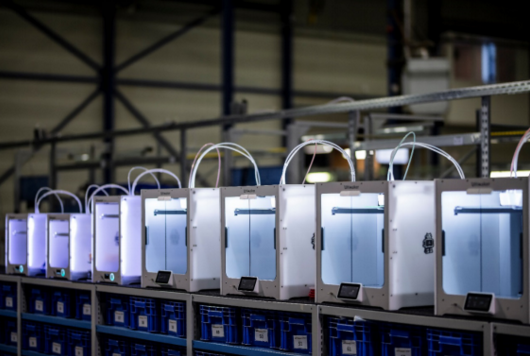In the future, what changes will 3D printing bring to the supply chain? Have you thought about this problem?
In recent years, the upsurge of 3D printing applications is sweeping the world. We can see 3D printing in many industries, such as 3D printed aircraft and auto parts in manufacturing, and 3D structural models used in plastic surgery. This undoubtedly does not prove that 3D printing has quietly penetrated into all walks of life.
In the entire supply chain, from manufacturing to logistics and warehousing, 3D printing is increasingly recognized, accepted and applied. Many world-renowned automobile brands have used 3D printing technology to accelerate the development and production of new products in their supply chains, and are more actively responding to changes in market demand.
Although 3D printing can never be compared with the economies of scale brought by the traditional mass production supply chain, with the advancing of time, 3D printing technology is becoming more powerful and reliable, and it is complementary to the supply chain. Profoundly promote the transformation and upgrading of the supply chain.

According to Gartner data, 38% of supply chain managers already use 3D printing technology, and 47% of supply chain managers plan to start using 3D printing technology in the next two years. Based on this calculation, in two years, 17 out of every 20 supply chain professionals will use 3D printing technology in their distribution network.
Today, 3D printing technology is playing an indispensable role in the supply chain with the following six advantages.
1. Avoid the negative impact of outsourcing production
Under the traditional supply chain model, companies often need to purchase raw materials from external suppliers, then mass-produce them in factories, and then distribute them to customers through warehousing and distribution networks. Therefore, a large amount of enterprise funds are used in plant construction, equipment purchase and staffing, which has caused the entire supply chain to become complicated and increase the difficulty of enterprise management.
Out of economic considerations, companies have been outsourcing their supply chains to companies that use traditional manufacturing methods for decades. However, international freight costs are increasing year by year, trade tariff disputes are intensifying, and the risks and costs of international logistics are also rising. The time required for companies to negotiate with multiple suppliers and independent contractors, as well as communication problems in different time periods, language differences and other factors also make outsourcing work more complicated.
As a result, the outsourcing supply chain has become more fragmented than ever, making it begin to lose its previous advantages.
The end-to-end process brought by 3D printing is a mature production model and a key advantage of 3D printing. With 3D printing technology, companies can use simple and professional operating software to realize self-production of the originally outsourced supply chain. For example, some companies use internal 3D printing equipment to produce prototypes or even small batch production, which can avoid the risk of intellectual property leakage due to the outsourcing of prototype production.
2. Save time and money by simplifying the supply chain
Compared with outsourcing, the return on investment of 3D printing is usually higher, and simplifying the supply chain can also save costs in many other ways.
2.1 Transportation cost
The logistics cost of shipping spare parts or parts with low turnover rate from overseas is very high, and 3D printing can help solve this problem. As long as a 3D printer is installed, parts can be produced on demand. A study shows that this can help companies save up to 85% of transportation costs.
2.2 Warehousing
Excess inventory and low turnover parts occupy a lot of storage space. Related research also shows that by reducing the inventory of finished products, companies can save 17% of costs. According to a report released by DHL, 3D printing spare parts can account for more than 20% of an ordinary company’s unused or excess inventory. Many automakers need to reserve 7-10 years of spare parts for each car they produce. With the advantages of 3D printing, the factory can realize on-demand production without having to prepare inventory in advance.
2.3 Improve profitability
According to public data from the US Bureau of Labor Statistics and manufacturing economic data, it is estimated that the operating cost of the US manufacturing industry is US$4,258,341 per minute, and the profit margin is only US$22,480 per minute.
Therefore, if 3D printing can shorten the production time, even if it is one minute, one hour, one week or one month, then it can have a positive impact on large industries. Although the use of 3D printing technology to produce a single prototype part in the enterprise does not seem to save a lot of cost, for those large manufacturing plants, the time or money saving effect will be quickly added.
2.4 Reduce material waste
3D printing produces parts in a layered manner. Unlike subtractive manufacturing methods such as CNC machining, additive manufacturing only produces consumables when needed. 3D printing produces parts or tools according to the exact specifications provided by the manufacturer and as needed, so waste can be reduced.
2.5 Reduce manpower requirements
For American companies, labor costs overseas are lower than those of domestic workers in the United States. Therefore, many manufacturers will outsource labor, but if 3D printing is used, it can reduce the company’s dependence on labor outsourcing. Thanks to the improvement of the running time and reliability of 3D printers, and the machines started by the network can be controlled by intuitive printer management software, a trained worker can control small spare parts at the workstation to achieve production through 3D printing.
3. Make the entire value chain more agile
While the complexity of the traditional supply chain is increasing, the responsiveness is rarely improved. 3D printing can shorten the manufacturing cycle, reduce overseas transportation activities, and almost save the lead time. The 3D printing time of a part depends on the complexity of the part, and is usually measured in hours rather than weeks. Using multiple machines can easily increase output and meet demand. The infinite flexibility and strong responsiveness of 3D printing can help companies have a stronger competitive advantage. As the supply chain continues to transform to this modern model, companies can improve efficiency in other areas.
4. Make full use of the unique product performance of 3D printing
3D printing brings significant advantages for small-batch manufacturing-breaking the limitations of geometric shapes. Traditional production methods such as injection molding follow the “design for manufacturing” principle, which limits the shape of the product. And 3D printing can design irregular geometric shapes more efficiently by generating design patterns, thereby improving the structural performance of products, saving materials, and shortening the design-to-manufacturing cycle.
5. Realize differentiation through on-demand production of parts
Like the “Uber” that disrupted the taxi industry and the “Airbnb” that disrupted the hotel industry, 3D printing can continue to strengthen consumers’ influence on the supply chain. In an environment where digitalization powers the “demand economy”, 3D printing and interconnected manufacturing will have a perfect synergy effect.
The on-demand production of parts helps to manufacture finished products or “quasi-finished products” with a higher level of personalization (such as clothing with personalized printing accessories, mobile phone cases with customized designs, and ergonomically designed products for workers. tool).
For the traditional supply chain, the on-demand production characteristics of 3D printing can guarantee the supply of products. Fundamentally speaking, 3D printers can replace “instant” inventory. The virtual warehouse has now become a reality, it can digitally send 3D model files to the nearest 3D printer.
6. Improve customer satisfaction
In the manufacturing industry, competition between enterprises is often competition between supply chains. On the premise that the company maintains the best service level, embedding 3D printing in the supply chain can improve customer satisfaction and loyalty.
For a company, through the improvement of the supply chain, it can achieve faster response to customers and the ability to respond to diverse needs, thereby bringing users a better consumer experience and allowing the company to stand out from the fierce competition. We have seen that due to the popularity of mobile phones, developing countries are phasing out fixed phones. People always favor technologies that are more flexible and require less infrastructure.
With the popularization of Industry 4.0 technology, 3D printing will revolutionize the current complex traditional supply chain model and bring unexpected changes to the entire industry. Ultimaker will also work closely with outstanding companies through business development, and use 3D printing technology to help companies improve the supply chain and accelerate the transformation of local digital manufacturing.

